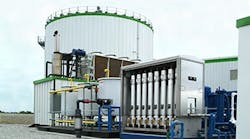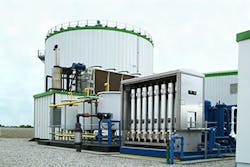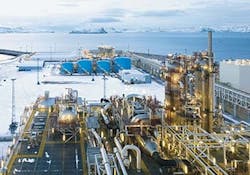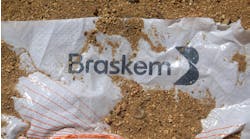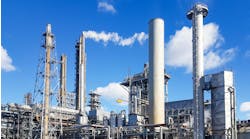Membranes are winning new roles for separating components in biogas and natural gas, as well as for tackling process problems, according to vendors including Air Products, Linde, BASF, Evonik and Air Liquide.
Biogas upgrading is growing in importance, notes John Hoffmann, marketing and business development specialist, Air Products Prism Membranes, St. Louis. “Air Products anticipates that this market will continue to see expansion as economies are committing to carbon-neutral energy policies.”
For example, a consortium is running a demonstration project in Japan that puts farm wastes through biodigestion and separates the biomethane with Prism PB separators (Figure 1); reforming yields hydrogen, which is distributed as “green hydrogen” for vehicle fuel.
“We see these types of multidisciplinary projects gaining popularity as demand increases for green fuels of all types,” he adds.
Hoffmann also points to a growing demand for recovery of rare gas, such as helium, as legacy sources become depleted.
In addition, the company increasingly is tailoring its technologies to solve specific gas-separation challenges at process plants. He cites as an example a problem Chinese glycol manufacturer Xinjiang Tianye Group, Shihezi City, faced; it sought a safe and economical way to remove unwanted hydrogen from the glycol manufacturing process. Hoffman outlines the challenge: “Legacy hydrogen membrane separation equipment is designed to operate at oil refineries and petrochemical facilities, where gas streams are in the 70–90 Barg range. This pressure requirement makes these membrane systems inefficient at facilities with lower-pressure reaction equipment such as this glycol plant.”
Figure 1. Growing interest in green fuels is making biogas upgrading increasingly important. Source: Air Products.
The manufacturing process involves reacting dimethyl oxalate and carbon monoxide over a palladium catalyst to create the synthesis compounds required to produce glycol. However, a buildup of hydrogen molecules during the process slows the reaction down.
Air Products’ answer is a treatment array of 104 PB6050-P3 membrane separators, each processing approximately 230 Nm3/hr of feed gas. The single-stage system passes the feed gas through the bore of the hollow fibers in the membranes. This affords more-efficient molecular diffusion than with the shell-side feeds of the single-end membrane separators originally used at the site. The membrane separators reduce the hydrogen concentration by 76% to 239 ppm. The system became fully operational in 2017.
This arrangement facilitates very large flow volumes, enabling a compact system. The low pressure requirements minimize the compression needed, making the process economical to operate, too.
Overall Xinjiang Tianye reportedly saved $700,000 on capital expenditure versus cryogenic technology, another option it investigated to remove the hydrogen.
In the future, hybrid membrane systems such as vacuum-swing-adsorption/membrane or membrane/cryogenics could provide economical answers in a number of process situations, for example debottlenecking, believes Adam Kratochvil, senior principal development engineer, Air Products Prism Membranes. “Additionally, materials development is reaching a point of viability that enables or improves high value separations such as olefin/paraffin,” he says.
Last year, the company presented a research summary on the development and scaleup of thermally rearranged hollow-fiber membrane technology at a conference of the North American Membrane Society. “This technology provides step-change performance for the natural gas sweetening market. And it is just one of many new membrane materials in various stages of development,” notes Kratochvil.
Natural Gas Initiative
“Regarding the natural gas, hydrogen and helium market, we see a very big potential in the coming years partly due in part to strongly increasing demand. With our current technologies and the potential combinations of those, we are confident to be well prepared for future challenges,” says Alexander Brandl, vice president business development & sales adsorption and membrane plants, Linde Engineering, Pullach, Germany.
Figure 2. Collaboration among German companies aims to provide better membrane systems. Source: Linde.
As part of Linde Engineering’s drive to improve and optimize its technologies, the company announced in February a collaboration on natural gas processing with BASF, Ludwigshafen, Germany (Figure 2). The goal is to use BASF’s Durasorb adsorbents to improve Linde Engineering’s high-performance membrane processes and provide an attractive, lower-cost option for processing natural gas high in carbon dioxide and heavy hydrocarbons.
BASF and Linde will perform the required design work to ensure the adsorbent is well suited to the membrane. Linde will supply both the membrane unit and the Durasorb-based pretreatment unit located upstream.
“The collaboration is a strong signal to the natural gas industry and will open access to previously inaccessible gas compositions for treatment,” notes Detlef Ruff, senior vice president process catalysts at BASF.
In June, BASF added Durasorb HG to its portfolio. This mixed metal adsorbent is designed to quickly and efficiently remove mercury from natural gas.
Meanwhile, in June 2018, Linde and Evonik, Essen, Germany, signed a cooperation agreement on the use of membranes for natural gas processing; Evonik focuses on the membrane and polymer side while Linde’s engineering division serves as the system integrator for the complete “HiSelect” membrane package units. At the heart of the technology is Evonik’s Sepuran family of hollow-fiber membranes, which come in versions tailored for a variety of specific applications.
“Evonik's high-selectivity membrane in combination with our other established gas separation technologies, such as our world-class adsorption technology, allows us an extraordinary flexibility in the development and application of new and more efficient purification processes,” says Tobias Keller, head of the adsorption and membrane plants product line of Linde’s engineering division.
The 2018 deal strengthened an earlier relationship between the two companies, which, in 2016, resulted in the startup of a plant for helium upgrading in Mankota, Canada. This is the first plant of its kind to combine membrane and pressure swing adsorption technologies. It currently processes more than 250,000 std m3/d of crude gas and produces 99.999% pure helium.
“The PSA and membrane units which are an integral part of the Mankota plant are already well known in industry and we are currently in negotiations for several promising projects which would use this or a similar set-up for the production of helium,” adds Brandl.
Biogas Success
Air Liquide Advanced Separations, Houston, counts biogas upgrading as one of its key business sectors. The company’s technology is based on its polymer membranes that remove carbon dioxide and other volatile pollutants such as odors from biogas. The system can generate biomethane with a methane content of between 96.5% and 99%, depending on its planned use. This high-quality biogas then gets delivered to customers by injection into the standard natural gas pipeline infrastructure or via liquefied gas tankers.
So far, the company has installed the technology at 25 sites around the world and owns its own biogas upgrading plant near Atlanta, which purifies landfill gas before injection into a local gas pipeline.
Another important growth area is recovery and purification of hydrogen at refineries. Feedstock and residual gas usually contain significant amounts of hydrogen. Use of membrane technology to handle this hydrogen can provide increased hydroprocessing throughput rates as well as prolonged catalyst life and performance, notes Air Liquide. The membranes can achieve hydrogen recoveries of more than 95% and hydrogen purities exceeding 99%, says the company. Moreover, the skid-mounted membranes have no moving parts, boast low capital and operating costs, provide a cheap source of hydrogen, and typically offer payback times of less than a year, it adds.
